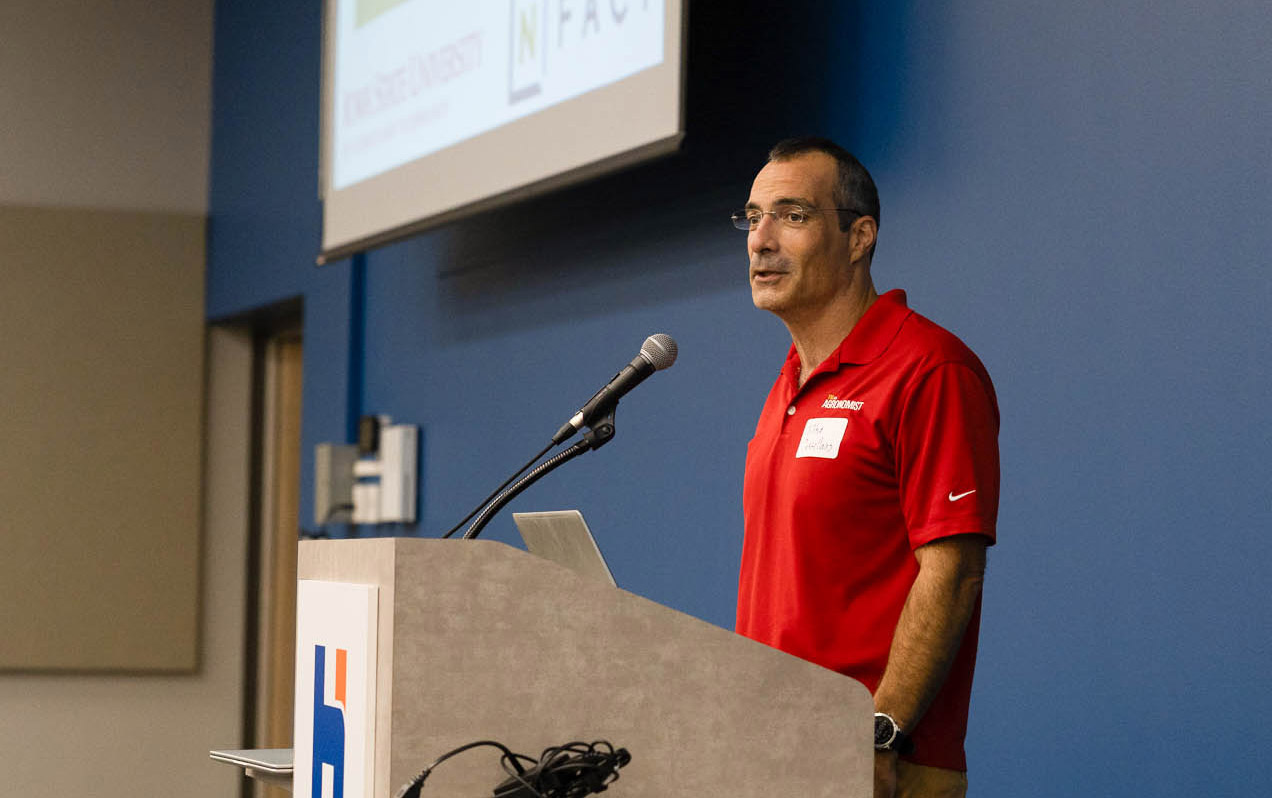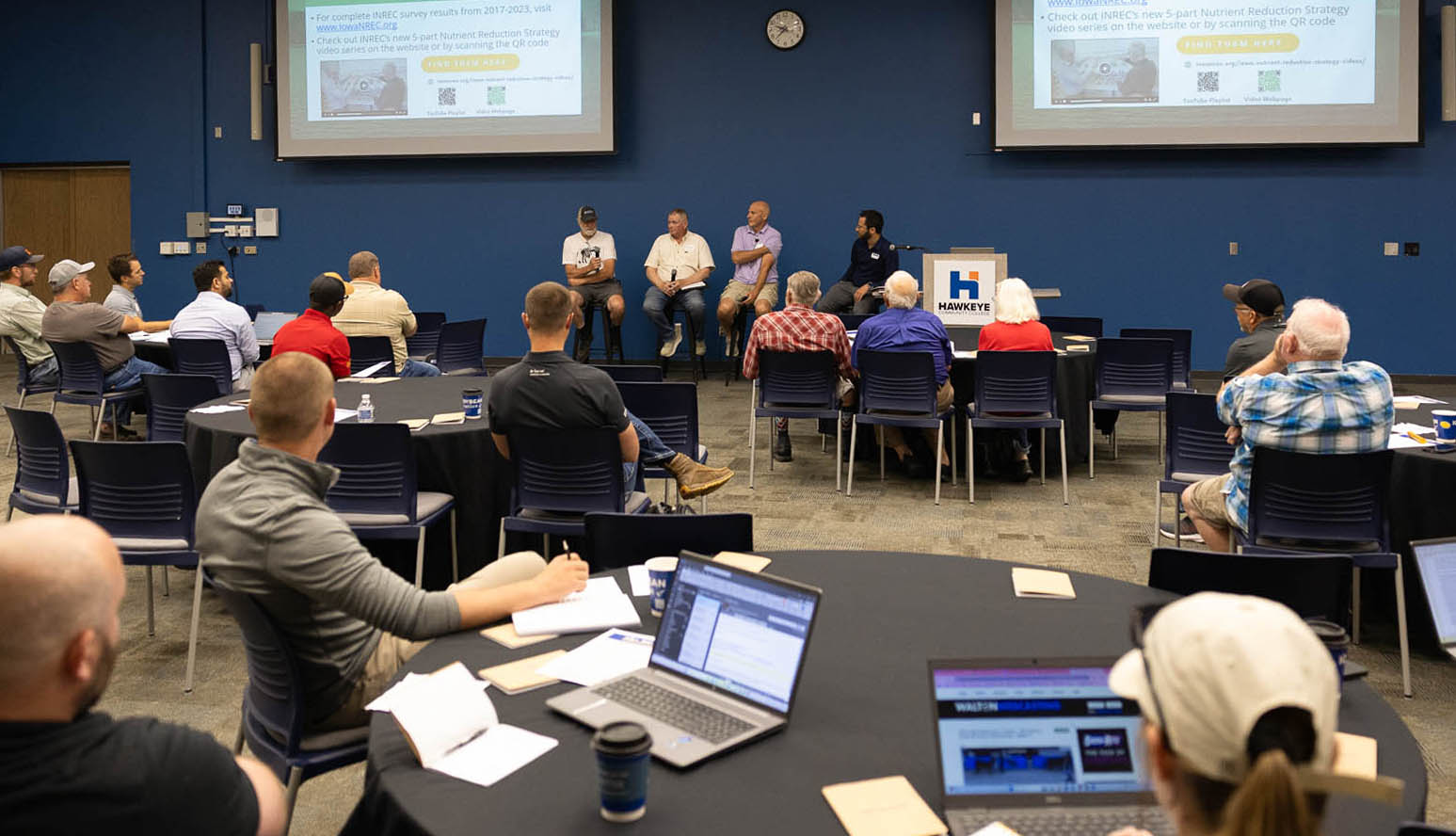
Mike Castellano, ISU professor and Iowa Nitrogen Initiative lead. (Photo: Iowa Soybean Association / Joclyn Kuboushek)
Profitable nitrogen decisions and on-farm research
July 17, 2025 | Kriss Nelson
The Iowa Nitrogen Initiative helps farmers make better nutrient decisions, understand research and see a positive return on investment.
Iowa Nitrogen Initiative
The Iowa Nitrogen Initiative, a public-private partnership, aims to make nitrogen management more precise and efficient. Highlights of the initiative were presented during a recent 4R event hosted by the Iowa Soybean Association (ISA).
ISA collaborates with Iowa State University (ISU) to conduct on-farm trials, recruit farmers and support nitrogen management practices.
“We’ve worked with farmers to conduct thousands of replicated, on-farm trials across the state,” says Mike Castellano, ISU professor and Iowa Nitrogen Initiative lead. “It’s a completely new approach to nitrogen management. Not just for Iowa, but nationally.”
N-FACT
Less than three years into the project, a new tool to help farmers make nitrogen decisions based on real, on-farm trial data has been developed.
The new N-FACT tool (Nitrogen Fertilizer Application Consultation Tool) replaces the outdated Maximum Return to Nitrogen (MRTN) calculator.

What affects optimum nitrogen rates?
Castellano shared early results from the initiative’s on-farm nitrogen trials, highlighting how nitrogen needs can shift significantly across geography and growing conditions.
Using trial data from 2023 and 2024, two very different weather years, the research revealed a consistent pattern: optimum nitrogen rates tend to decrease from east to west across Iowa.
“We get more rainfall in the east, which can create greater demand for nitrogen. In the west, our loess soils are deeper and the environment is drier, giving roots more room to access nutrients. That reduces the need for added fertilizer,” he says.
The optimum nitrogen rate jumped 15% from 2023 to 2024, increasing from 196 to 224 pounds of nitrogen per acre.
Castellano tied the change to weather extremes.
“2024 was a wetter year,” he says. “That can lead to more nitrogen loss. But in 2024, we also had record yields, and that crop used more nitrogen. Both led to greater nitrogen needs. These trials show just how much nitrogen needs can vary from year to year and field to field.”
Cover crops and their effects on optimum nitrogen rate
The question of whether cover crops influence a field’s optimum nitrogen rate remains up in the air.
“There’s been a lot of mixed evidence,” says Castellano. “In scientific literature, it’s been mixed. When I talk to farmers, I also get mixed responses.”
Castellano shared results from the last two years of on-farm trials across Iowa. Researchers compared nitrogen needs and yields in fields with and without cover crops.
“There was really no difference in optimum nitrogen rate or yield,” Castellano says.
He noted that farmers' experience with cover crops, years of use and timing could all play a role.
“That might be why we’re not seeing a strong effect one way or another,” he says.
While the findings didn’t show a clear benefit or drawback, Castellano said that’s still a step forward.
“What this does show is that cover crops can have a positive effect or no effect,” he says. “That’s important. It means we can keep building on this without concern that they always hurt yield or efficiency.”
Planting dates’ effect on optimum nitrogen rates
One of the clearest predictors of how much nitrogen a crop will need, and how much it will yield, comes down to one thing: planting timing.
“As we know, earlier planting dates mean higher yields,” says Castellano. “But it also requires more nitrogen fertilizer when you plant early to get the crop growing. Ironically, despite having more fertilizer, the yield improvement is sufficient that the environmental outcomes tend to be better with earlier planting. Despite the fact that we are putting on more nitrogen fertilizer, we are getting more nitrogen uptake as well that is better timed with soil availability.”
Understanding nitrogen demand
As Iowa farmers strive to become more efficient with nitrogen, understanding what’s driving the need for more of it is key to making smarter decisions.
Castellano shared the three factors contributing drivers to increased nitrogen: yield, crop residue and precipitation.
Yield: “Thinking about what causes higher nitrogen use helps us manage it better,” says Castellano. “One of the biggest drivers is yield.”
According to Castellano, Iowa corn yields have been steadily increasing by about two bushels per acre each year.
“That’s over a pound of nitrogen per acre, per year, just in the grain,” he says. “If you’re taking more out of your bank account, you’ve got to put more in—it’s the same concept with nitrogen.”
Crop residue: “As yield increases, we’re also increasing the amount of crop residue that’s going into the soil.”
Crop residue has a high carbon-to-nitrogen ratio. It also keeps the soil colder and wetter, which increases nitrogen demand.
Research from Iowa State shows that partially harvesting crop residues, especially in high-residue environments, can reduce optimum nitrogen rates and even boost yields without sacrificing soil health.
“We’ve got far more residue now than we did 20 years ago,” Castellano says. “And with growing demand for biofuels, there’s a real opportunity to use some of that excess.”
Precipitation: “Some things are out of our control, and increasing precipitation is one of them and that increases nitrogen needs,” he says.
But increased precipitation also brings an opportunity to upgrade on-farm drainage systems.
“We know improving our drainage can decrease our optimum nitrogen rate, perhaps a little bit counterintuitively, but that’s because it reduces nitrogen losses to the atmosphere,” says Castellano. “If we can do that and put an edge-of-field practice in at the same time, not only will we have done the best things we can do for the environment, but we’re increasing profitability at the same time.”
Conservation is critical
Looking at a year potentially paired with high yields and higher environmental losses due to excess rain, Castellano says conservation practices are a necessity.
“We need those infrastructure practices,” he says. “Without them, we are not going to solve our nitrate loss challenges.”
Public understanding
Beyond helping farmers, Castellano said the data also plays a critical role in communicating the realities of modern agriculture to the public.
“This kind of information not only helps with decision-making on the farm,” he said, “it helps explain the complexity of farming to those outside the industry.”
Written by Kriss Nelson.
Back